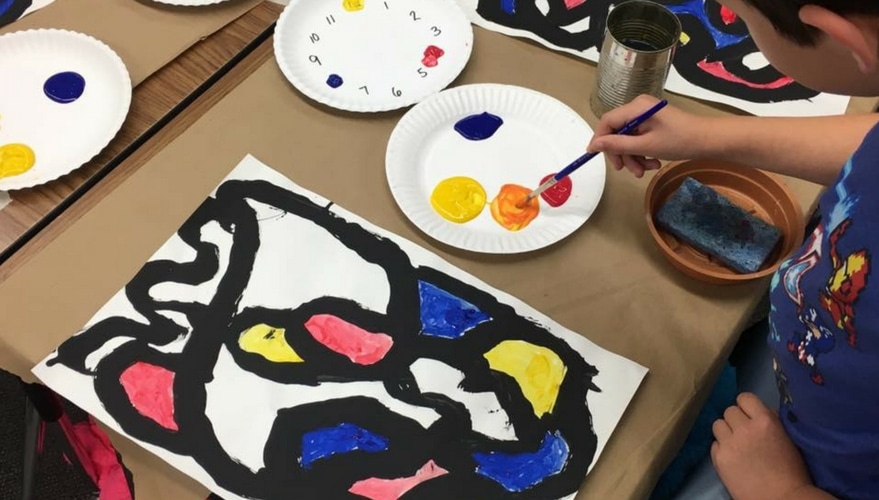By Marcia Osterink
Art is essential to every child’s education.
Today, more than ever, we realize how the world turns on the solutions and products of the creative thinkers. As the people of the world collectively hold their breaths waiting for a vaccine to save us all, scientists furiously work to find the creative solution.
“I thought this article was about the importance of art in education,” you say. “What does science have to do with art?” The simple answer is “Everything.”
But the traditional belief that art is a subjective, mindless activity denies the connection between thought processes and art. Surprisingly, it is the creative process taught in art that makes science possible.
So, what is the connection? Harvard psychology professor emeritus, Rudolf Arnheim, says that all thought processes rely on images, and that concept formation itself depends on a sophisticated processing of visual information. Courses in visual training (art) teach students to handle visual phenomena as the principle means of dealing with the organization of thought. In studio art, students are constantly making the connection between vision and abstraction while organizing compositions in painting, drawing and sculpture. When students are engaged in art production, they are using their mental capacities in a very intensive way. Solving structural problems on a practical, tangible level greatly helps students tackle organizational problems in all areas of study.
What is visual training? Teaching students ways to process visual information relies on the understanding of the dual functions of the brain. Roger Sperry, winner of the Nobel Prize in Physiology and Medicine, discovered that the two sides of the brain, the left and the right, have specialized functions and can operate practically independently.
And while the school day is almost entirely dedicated to the left side of the brain (the verbal, analytical, symbolic, abstract, rational, logical and linear), the right side of the brain (the spatial, synthetic, intuitive, holistic), the place where all visualization and imagining takes place, is neglected. Students can actually be taught to process visual information in a new way and make a cognitive shift from the left side of the brain to the right through drawing. Once learned, this skill can be applied to all areas of study requiring creative thinking or organization of thought.
How does this apply to science?
All invention and scientific discovery requires right brain thinking. Scientists can experiment and gather data forever, but if they can not make the shift and see the whole picture (holistic), if they can never pull all the little pieces of information together into a meaningful whole (synthetic), they will never make the leap of insight and invent.
But what about the value of Art for Arts Sake? What about teaching art for its sheer beauty and intrinsic value? What can be more valuable than acquiring the tools for self-expression?
Training in art expands the students’ visual awareness so that they are sensitive to the world around them. This is more important than ever in a world where students are glued to their devices. Students experience joy when creating works of art.
While the process of creation is the teacher, the art created is the product of accomplishment and pride. Success in the creation of art is one of the greatest self-confidence builders. In truth, students who are not being reached in the regular classroom may connect in the art room. Over and over again, I have witnessed students who are floundering socially and academically be completely turned around through success in the art room. Art is a source for tools and skills for creating and inventing.
While learning the skills of building a composition. making decisions about choices of colors and values, use of line, creating a vocal point and balance, students are also learning to dissect and appreciate the works of the great masters and contemporary artists. So as students create, they are learning perception, structure, design and communication.
Robert Root-Bernstein, professor of physiology at Michigan State University and a MacArthur Prize Fellow, says that art for arts sake is often in advance of science and technology. One example he gives is the geodesic domes invented by Buckminster Fuller, which revolutionized our understanding of the structure of viruses and carbon compounds called “fullerenes.”
Today, in a world of quarantine and isolation, people young and old who have been given the skills and tools to create art are thriving on this time for self-expression and, who knows, may be coming up with insights to the solutions we are so eagerly seeking.
How do you accomplish these goals with your students? What should art teach? The first step is to make a shift in attitude about the importance of art education and its place in the greater curriculum. Next, you must decide what your goals are for your students.
If your answer is you want students who are confident, and highly aware and sensitive to the world around them, students who can think, creatively and problem solve by transferring what they have learned in one area of study to another, you are ready to commit. Once convinced of the importance of art, the next step is to dedicate time to it.
This means at least one and a half to two hours a week. More is preferable, but, unfortunately, every subject matter is competing for minutes in the classroom.
And then you must find an art program with a curriculum that is hands-on, process-oriented and teaches right brain drawing, the elements and principles of art, composition in two and three dimensional art, and the appreciation of art which includes the art of other cultures and the history of art. Now is the time to make this shift.
Stop the nibbling away of the arts in your classrooms. Join the group of educators who are embracing the importance of the creative process and understanding the dual functions of the brain. Your students will be richly rewarded.
Marcia Osterink, a life-time art educator, is the creator of Arts Attack, an award-winning, video-based art curriculum now streaming in thousands of classrooms, www.artsattack.com.





